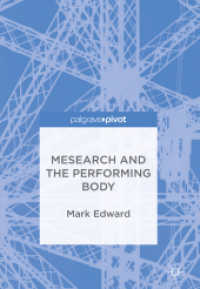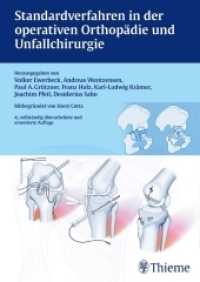- ホーム
- > 洋書
- > 英文書
- > History / World
Full Description
This study examines the scientific interests and rationality which find expression in the quadrivial sources of the 9th to 11th centuries, arguing on this basis for the existence of a 'discovery of nature' already prior to the 12th century. It focuses on the theme of 'time', exemplified by Abbo of Fleury's Computus, as well as Hermann of Reichenau's Epistola de quantitate mensis lunaris, Abbreviatio compoti and Prognostica.
The systematic and historical background of the study is established through analysis of Alcuin's De vera philosophia, Bede's De temporum ratione and the computistic-astronomical anthologies which were the predominant genre during this period. The volume is complemented by fourteen illustrations and an appendix including Hermann's heretofore unedited texts, the Abbreviatio compoti and Prognostica.
Contents
Abbildungsverzeichnis
Vorwort
Vorbemerkungen
Abkürzungsverzeichnis
Einleitung: Quid est enim ‚tempus'?
Kapitel 1. Adime saeculo computum
Computus und Wirklichkeitsverständnis.
1.1. Einleitung: Computus und Bildungsreform
1.2. Beda Venerabilis: „De temporum ratione"
1.2.1. Historische Einordnung
1.2.2. Zu Inhalt und Wirkung
1.3. DasKonzept der septem artes liberales.
1.3.1. Alkuin und die „Disputatio de vera philosophia" . 49
1.3.2. Alkuins „Disputatio": Zum Inhalt.
1.3.3. Alkuins „Disputatio": Erörterung
1.3.4. Wissen im Rahmen der artes
1.4. Computus und Quadrivium
Kapitel 2. Alme deus, te nosse mihi concede fideli
Quadrivium und Gotteserkenntnis
2.1. Einleitung: Die quadrivialen Sammlungen am
Beispiel Abbos von Fleury.
2.2. Der „Computus" als komputistisch-astronomische Sammlung. 88
2.2.1. Die komputistisch-astronomischen Sammlungen . 88
2.2.2. Der „Computus" Abbos von Fleury
2.2.3. Ergebnisse
2.3. Untersuchung ausgewählter Komponenten des „Computus" . 119
2.3.1. Diagramme.
2.3.2. Tabellen und Kalendarien.
2.3.3. „Ephemerida".
2.4. Unum - verbum - natura - ordo
Kapitel 3. Discursus siderum semper aequalis
Himmelsbewegung und Gleichförmigkeit
3.1. Einleitung: Gleichförmigkeit als Maß im Quadrivium am
Beispiel Hermanns von Reichenau
3.2. Hermanns komputistisch-astronomische Schriften.
3.2.1. Die „Epistola de quantitate mensis lunaris"
3.2.2. Der erste Teil der „Abbreviatio compoti":
Das komputistische Lehrbuch
3.2.3. Der zweite Teil der „Abbreviatio compoti":
Das Spezialproblem.
3.2.4. Die „Prognostica de defectu solis et lunae"
3.3. Modellhaftes Denken
3.3.1. Computus und natura
3.3.2. Mathematik und Wirklichkeit
3.3.3. Aequalitas als ratio naturalis
3.4. Die Besonderheiten modellhaften Denkens
Zusammenfassung und Ausblick: De temporum ratione
Appendix.
I. „Abbreviatio compoti cuiusdam idiotae"
II. „Prognostica de defectu solis et lunae"
Quellen und Literatur
I. Handschriften
II. Zitierte Quellen
III. Zitierte Sekundärliteratur
Indices
I. Index nominum.
II. Index rerum.








